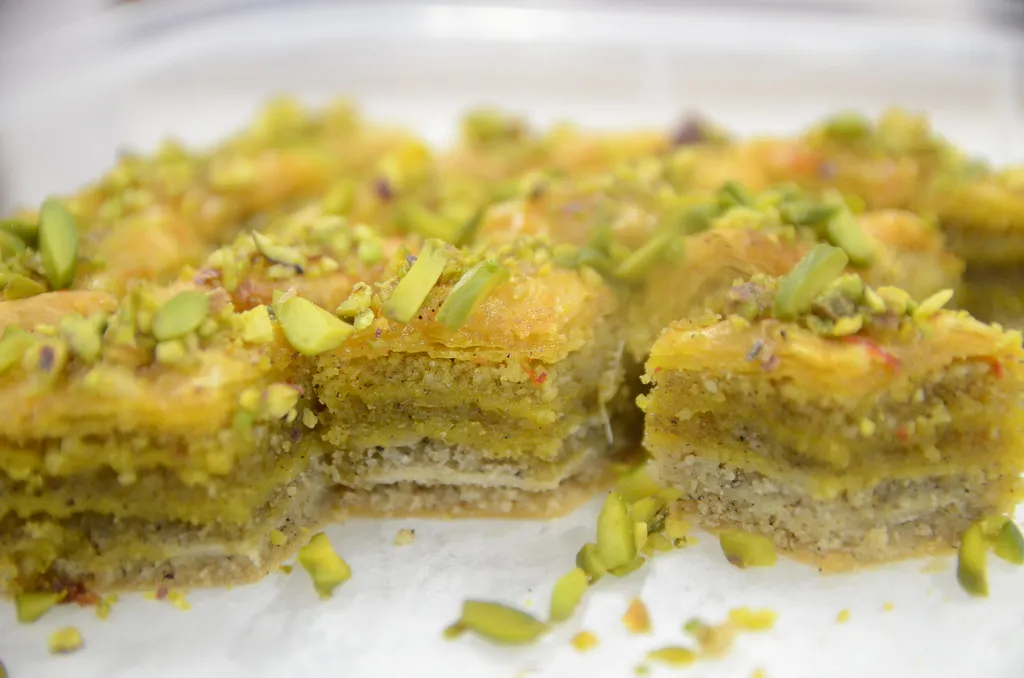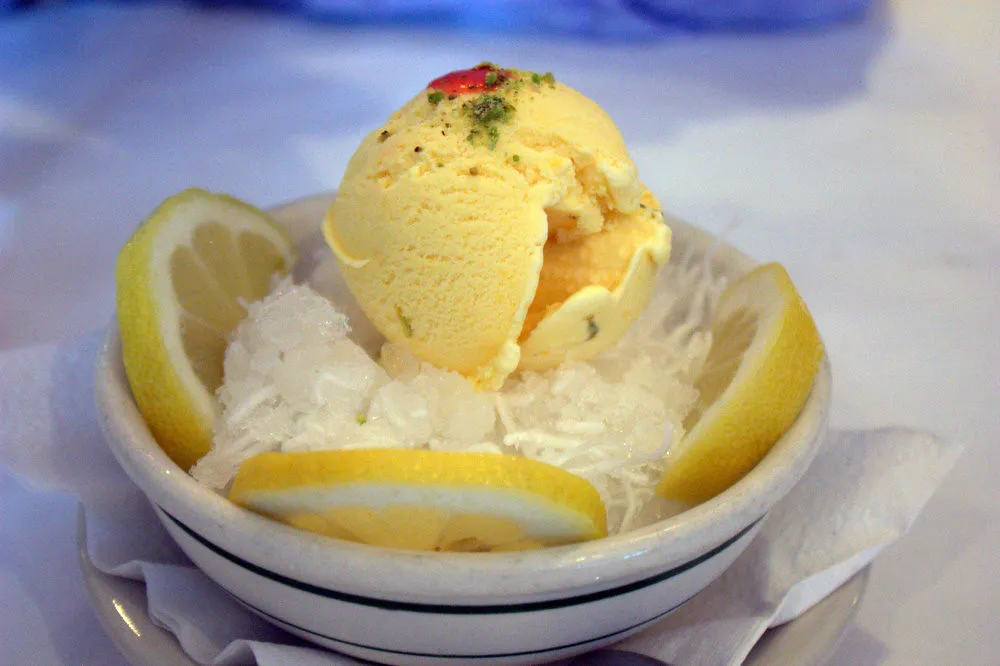The Best Fluffy Pancakes recipe you will fall in love with. Full of tips and tricks to help you make the best pancakes.
Iranian desserts are a delightful blend of rich history, unique flavors, and beautiful presentation. Rooted in centuries-old Persian traditions, these sweets are known for their fragrant ingredients like saffron, rosewater, and pistachios — flavors that instantly transport you to the heart of Persian cuisine. Whether it’s the delicate layers of baklava, the refreshing coolness of faloodeh, or the crunchy sweetness of zoolbia and bamieh, Iranian desserts offer something for every palate.
In this blog post, we’ll explore some traditional Iranian dessert recipes made simple enough for you to try at home today. Whether you’re new to Persian sweets or looking to deepen your culinary repertoire, these easy-to-follow recipes and tips will help you create authentic, delicious treats that capture the essence of Iran’s rich dessert heritage. Let’s dive into the sweet world of Persian desserts and bring a taste of Iran to your kitchen!
Easy Iranian Dessert Recipes for Beginners
If you’re new to Persian sweets, these easy-to-make Iranian desserts are a perfect starting point. They use simple ingredients and straightforward methods, allowing you to experience authentic flavors without any hassle. Here are three beginner-friendly recipes to try:

1. Persian Love Cake
Ingredients:
- 1 cup all-purpose flour
- 1/2 cup sugar
- 1/4 cup butter, softened
- 2 eggs
- 1/4 cup milk
- 1 teaspoon baking powder
- 1 teaspoon rosewater
- 1/2 teaspoon ground cardamom
- A handful of chopped pistachios (for garnish)
Preparation:
- Preheat your oven to 350°F (175°C) and grease a small cake pan.
- In a mixing bowl, cream the softened butter and sugar until light and fluffy.
- Beat in the eggs one at a time, mixing well after each addition.
- Stir in the rosewater and milk.
- In a separate bowl, sift together the flour, baking powder, and ground cardamom.
- Gradually add the dry ingredients to the wet mixture, folding gently until combined.
- Pour the batter into the prepared pan and smooth the top.
- Bake for 25-30 minutes or until a toothpick inserted comes out clean.
- Let the cake cool, then garnish with chopped pistachios before serving.
2. Iranian Honey and Almond Sweets
Ingredients:
- 1 cup almond flour
- 1/2 cup honey
- 1/4 teaspoon ground cardamom
- 1 tablespoon rosewater
- A handful of sliced almonds (for topping)
Preparation:
- In a mixing bowl, combine almond flour and ground cardamom.
- Warm the honey slightly to make it easier to mix.
- Add honey and rosewater to the almond mixture, stirring until you get a sticky dough.
- Shape the dough into small balls or logs.
- Place on a baking sheet lined with parchment paper and press sliced almonds on top of each piece.
- Refrigerate for at least an hour until firm.
- Serve chilled as a sweet, nutty treat.
3. Persian Faloodeh (Traditional Rosewater Noodle Dessert)
Ingredients:
- 1/2 cup thin rice noodles or vermicelli
- 3 cups water
- 1 cup sugar
- 2 tablespoons rosewater
- Juice of 1 lime or lemon
- Crushed pistachios (optional, for garnish)
Preparation:
- Cook the rice noodles in boiling water until tender (about 5 minutes). Drain and rinse under cold water to stop cooking.
- Prepare a simple syrup by heating sugar with 1 cup water until the sugar dissolves completely. Let it cool.
- Add rosewater and lime juice to the syrup.
- Mix the cooled noodles into the syrup, stirring gently to coat.
- Chill the mixture in the refrigerator for 1-2 hours before serving.
- Garnish with crushed pistachios or a splash of lime juice for extra flavor.
Classic Persian Sweets You Should Try
Iranian cuisine is famous for its rich and diverse array of traditional sweets that have been perfected over centuries. These classic Persian desserts not only showcase unique flavors like saffron, rosewater, and pistachios but also hold a special place in Persian culture and celebrations. Here are some iconic Persian sweets you should definitely try making or tasting:

1. Persian Baklava: Layers of Saffron and Nuts
Overview:
Baklava is a famous layered pastry known throughout the Middle East, but Persian baklava has its own unique twist. It’s made with thin sheets of dough layered with chopped pistachios and almonds, infused with fragrant saffron and rosewater syrup, resulting in a rich and aromatic dessert.
Ingredients:
- Phyllo dough sheets
- 2 cups chopped pistachios and almonds
- 1 cup butter, melted
- 1 teaspoon ground cardamom
- 1/2 teaspoon ground cinnamon
- 1 cup sugar
- 1 cup water
- 1 tablespoon rosewater
- A pinch of saffron threads, dissolved in 2 tbsp warm water
Preparation:
- Preheat the oven to 350°F (175°C). Butter a baking dish and layer about 6 sheets of phyllo dough, brushing each with melted butter.
- Spread a thin layer of the nut mixture (pistachios, almonds, cardamom, cinnamon) over the dough.
- Add 4-5 more phyllo sheets on top, brushing each with butter. Repeat layering nuts and phyllo until ingredients are used up, finishing with about 6 layers of phyllo on top.
- Cut the baklava into diamond shapes before baking.
- Bake for 40-45 minutes until golden and crisp.
- Meanwhile, make the syrup by boiling sugar, water, rosewater, and saffron water for about 10 minutes until slightly thickened.
- Pour the syrup over the hot baklava once it’s out of the oven. Let it soak and cool before serving.
2. Gaz: The Famous Persian Nougat
Overview:
Gaz is a traditional Persian nougat that originates from Isfahan, made from the sap of the wild tamarisk tree mixed with sugar, egg whites, pistachios, and sometimes almonds or walnuts. This chewy, sweet treat is often enjoyed with tea.
Ingredients:
- 2 cups sugar
- 1/2 cup water
- 2 egg whites
- 1/2 cup chopped pistachios
- 1 teaspoon rosewater
Preparation:
- In a saucepan, combine sugar and water and bring to a boil until it reaches the soft ball stage (about 240°F or 115°C on a candy thermometer).
- Beat egg whites until stiff peaks form.
- Slowly pour the hot sugar syrup into the egg whites while continuously beating to create a fluffy nougat mixture.
- Stir in rosewater and chopped pistachios.
- Pour the mixture into a lined tray and let it cool and set completely.
- Cut into small squares and enjoy with tea.
3. Zoolbia and Bamieh: Traditional Iranian Fried Treats
Overview:
Zoolbia and Bamieh are popular deep-fried sweets commonly enjoyed during Ramadan and other festivities. Zoolbia resembles a crispy, syrup-soaked lattice, while Bamieh is a small, syrup-drenched fried dough, similar to doughnut holes.
Ingredients:
For Zoolbia:
- 1 cup all-purpose flour
- 1 tablespoon cornstarch
- 1/2 teaspoon baking powder
- 1 cup yogurt
- 1/4 teaspoon saffron, dissolved in 1 tbsp warm water
Bamieh:
- 1 cup water
- 1/4 cup butter
- 1 cup all-purpose flour
- 2 eggs
- 1/2 teaspoon vanilla
Syrup:
- 2 cups sugar
- 1 cup water
- 1 tablespoon lemon juice
- 1 teaspoon rosewater
Preparation:
Zoolbia:
- Mix flour, cornstarch, and baking powder in a bowl.
- Whisk in yogurt and saffron water until you get a smooth batter. Let it rest for 1-2 hours.
- Heat oil for deep frying. Using a squeeze bottle or piping bag with a small tip, pipe the batter into hot oil in circular, lattice patterns. Fry until crisp and golden.
Bamieh:
- In a saucepan, boil water and butter together.
- Remove from heat and add flour all at once, stirring vigorously until a dough forms.
- Let cool slightly, then beat in eggs one at a time and add vanilla.
- Pipe small dough shapes into hot oil and fry until golden.
For Syrup:
- Boil sugar, water, and lemon juice until slightly thickened. Remove from heat and stir in rosewater.
- Immediately soak fried Zoolbia and Bamieh in the warm syrup for a few minutes before serving.
Using Key Persian Ingredients in Desserts
Persian desserts are renowned not only for their delicious flavors but also for the unique ingredients that give them their distinctive character. Understanding these key ingredients and how to use them will elevate your homemade Iranian sweets and bring authentic taste and aroma to your kitchen. Here are some of the most important Persian ingredients you should know about when making desserts:
1. Cooking with Saffron and Rosewater
Saffron:
Often called the “red gold” of spices, saffron is a prized ingredient in Persian cooking and desserts. It adds a beautiful golden hue and a delicate floral aroma. When using saffron, a little goes a long way. The best way to release its flavor and color is to soak a few strands in a tablespoon of warm water or hot milk before adding it to your recipes. Saffron is used in sweets like Persian Love Cake, baklava, and rice flour desserts.
Rosewater:
Rosewater is distilled from rose petals and lends a subtle, fragrant floral note to many Persian sweets. It is essential in dishes like faloodeh, gaz (nougat), and zoolbia. Rosewater should be added sparingly — usually a teaspoon or two — to prevent overpowering the other flavors. High-quality rosewater is best for achieving that authentic Persian taste.
2. Pistachios and Almonds: Persian Dessert Staples
Pistachios:
Pistachios are the iconic nuts of Persian cuisine, celebrated for their vibrant green color and rich, slightly sweet flavor. They are used both as a key ingredient and as a garnish to add texture and visual appeal. You’ll find them in desserts like baklava, Persian Love Cake, and many honey-based sweets. When using pistachios, lightly toasting them enhances their flavor.
Almonds:
Almonds are also widely used in Persian desserts, providing a creamy texture and mild nutty taste. Ground almonds are often incorporated into doughs and batters, while slivered or sliced almonds are used as toppings. Almonds pair beautifully with honey, rosewater, and cardamom in sweets such as almond and honey bites and nougat.
3. The Role of Cardamom and Honey in Flavoring
Cardamom:
Cardamom is a fragrant spice commonly used in Persian desserts for its sweet, slightly spicy, and citrusy flavor. It pairs well with nuts, honey, and floral ingredients like rosewater and saffron. Cardamom can be ground and added to cakes, cookies, and syrups to add depth and warmth. In Persian Love Cake and many traditional sweets, cardamom is an indispensable spice.
Honey:
Honey is a natural sweetener that adds a rich, floral sweetness to Persian desserts. It is often combined with nuts or used in syrups to soak pastries like zoolbia and bamieh. Honey can also be drizzled over simple treats or used in combination with rosewater and spices to create complex flavor profiles typical of Persian sweets.
Tips for Perfecting Your Iranian Desserts at Home
Making Iranian desserts at home can be a delightful experience, but to truly capture the authentic flavors and textures, a few key tips and techniques can help you elevate your creations from good to extraordinary. Here are some practical and cultural tips to perfect your Persian sweets in your own kitchen:

1. Use Fresh and High-Quality Ingredients
The essence of Persian desserts lies in their fragrant, natural ingredients. Always opt for the freshest spices like saffron and cardamom, high-quality rosewater, and fresh nuts such as pistachios and almonds. Fresh saffron threads, for example, have a more vibrant aroma and color than pre-ground powder. Similarly, homemade or premium rosewater will give your sweets a more authentic floral note compared to synthetic alternatives.
2. Master the Art of Balancing Flavors
Persian desserts are known for their delicate balance between sweetness, floral notes, and warm spices. Avoid making your sweets overly sweet; many traditional recipes emphasize subtlety, where the natural flavors of nuts, saffron, and rosewater shine through. Taste your syrup or batter before finalizing to ensure the sweetness complements, rather than overwhelms, the other flavors.
3. Soak Saffron Properly to Maximize Flavor and Color
Saffron is one of the most prized ingredients in Persian desserts, but its flavor and color are only fully released when soaked properly. Always crush a few saffron threads between your fingers or with a mortar and pestle, then steep them in a small amount of warm water, milk, or syrup for at least 10-15 minutes before adding to your recipe. This technique ensures an even distribution of saffron’s unique taste and its beautiful golden hue.
4. Use the Right Tools and Techniques for Texture
Using the Right Tools and Techniques for Texture
Texture is crucial in Persian sweets—whether it’s the chewy softness of gaz nougat or the crisp layers of baklava. For precise temperature control when making syrups or baking delicate pastries, using a reliable kitchen thermometer can make all the difference. We recommend the Ninja Foodi Digital Cooking Thermometer for accurate results in your dessert preparations.
5. Let Syrups Soak Thoroughly
Many Persian desserts rely on sweet syrups infused with rosewater, saffron, or lemon juice. After baking or frying, pour the warm syrup evenly over the hot dessert to allow it to soak deeply, giving the sweet its signature moist texture and intense flavor. Patience is key—let your dessert rest for several hours or even overnight to absorb the syrup fully for the best taste and texture.
6. Practice Patience and Enjoy the Process
Many Iranian desserts are crafted with love and patience, reflecting centuries of tradition. Don’t rush the steps, especially when layering, soaking, or cooling. Take your time to appreciate the aromas and textures developing during preparation. The process itself is part of the enjoyment, bringing a piece of Persian culture right into your home kitchen.





